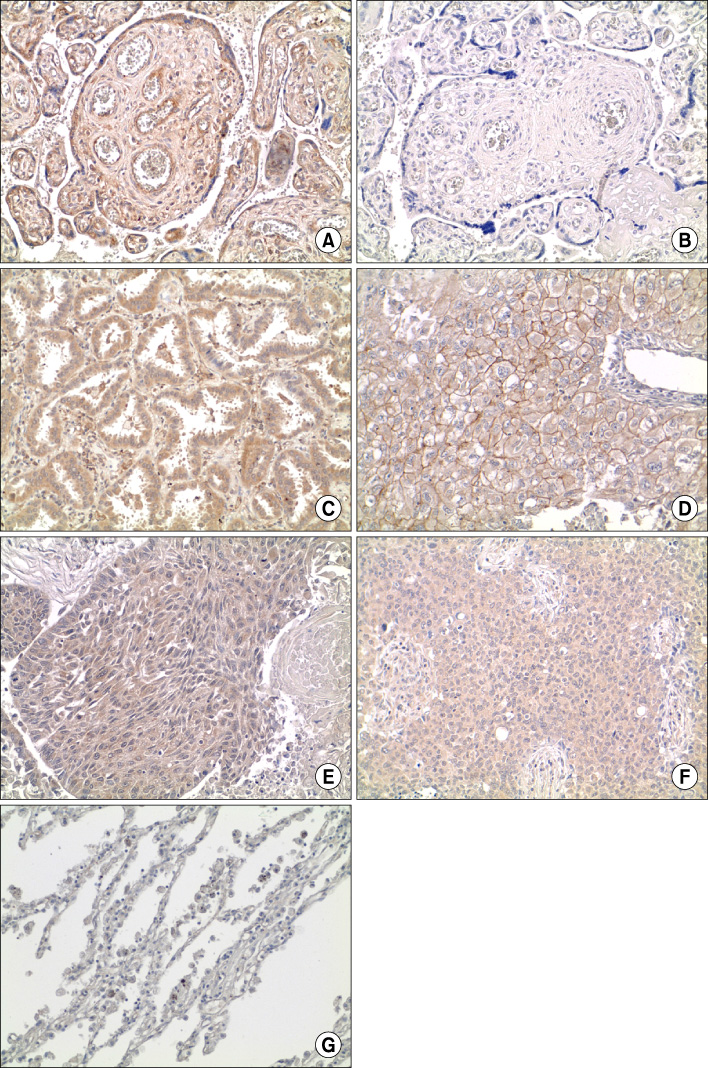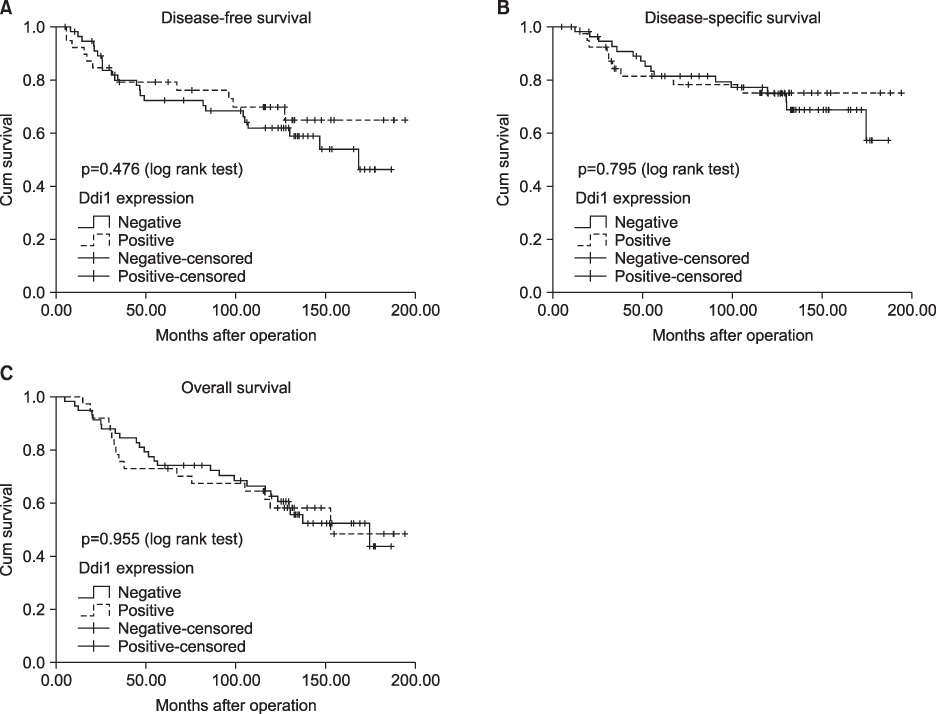Tuberc Respir Dis.
2012 Feb;72(2):124-131.
DNA-Damage Inducible 1 is a Property of Human Non-Small Cell Lung Cancer
- Affiliations
-
- 1Division of Pulmonary and Critical Care Medicine, Department of Internal Medicine and Lung Institute, Seoul National University College of Medicine, Seoul, Korea.
- 2Department of Internal Medicine, Yonsei University Health System, Yonsei University College of Medicine, Seoul, Korea. sekyukim@yuhs.ac
- 3Department of Pathology, Yonsei University Health System, Yonsei University College of Medicine, Seoul, Korea.
Abstract
- BACKGROUND
DNA damage-inducible 1 (Ddi1), one of the ubiquitin-like and ubiquitin-associated family of proteins, may function in the regulation of the ubiquitin-proteasome pathway, which has been validated as a target for antineoplastic therapy. We investigated Ddi1 expression in human lung cancer tissues and evaluated the relationship of this expression pattern with clinicopathological factors in patients with non-small-cell lung cancer (NSCLC).
METHODS
Ddi1 expression was examined by immunohistochemistry in tumor tissues from 97 patients with stage I NSCLC, who had undergone curative surgical resection at two tertiary referral hospitals from 1993~2004. None of the patients received preoperative chemotherapy and/or radiation therapy.
RESULTS
Thirty-nine (40.2%) of the 97 cases were positive for Ddi1. Ddi1 expression was dominantly seen in cytoplasm rather than in the nuclei of cancer cells in all histological types, whereas adjacent nontumoral lung tissue showed negative Ddi1 staining in most cases. Ddi1 expression tended to increase in well-differentiated tumors but without statistical significance. Positive Ddi1 expression was associated with a tendency for better disease-free survival and disease-specific survival, although the difference was not significant.
CONCLUSION
Ddi1 expression is a property of NSCLC. Because Ddi1 could be a potential target for cancer therapy, more research is needed to evaluate its role in NSCLC.
Keyword
MeSH Terms
Figure
Reference
-
1. Brundage MD, Davies D, Mackillop WJ. Prognostic factors in non-small cell lung cancer: a decade of progress. Chest. 2002. 122:1037–1057.2. Groome PA, Bolejack V, Crowley JJ, Kennedy C, Krasnik M, Sobin LH, et al. The IASLC Lung Cancer Staging Project: validation of the proposals for revision of the T, N, and M descriptors and consequent stage groupings in the forthcoming (seventh) edition of the TNM classification of malignant tumours. J Thorac Oncol. 2007. 2:694–705.3. Ciechanover A. The ubiquitin-proteasome proteolytic pathway. Cell. 1994. 79:13–21.4. Hoeller D, Dikic I. Targeting the ubiquitin system in cancer therapy. Nature. 2009. 458:438–444.5. Su V, Lau AF. Ubiquitin-like and ubiquitin-associated domain proteins: significance in proteasomal degradation. Cell Mol Life Sci. 2009. 66:2819–2833.6. White RE, Powell DJ, Berry C. HIV proteinase inhibitors target the Ddi1-like protein of Leishmania parasites. FASEB J. 2011. 25:1729–1736.7. Gills JJ, Lopiccolo J, Tsurutani J, Shoemaker RH, Best CJ, Abu-Asab MS, et al. Nelfinavir, A lead HIV protease inhibitor, is a broad-spectrum, anticancer agent that induces endoplasmic reticulum stress, autophagy, and apoptosis in vitro and in vivo. Clin Cancer Res. 2007. 13:5183–5194.8. Gills JJ, Lopiccolo J, Dennis PA. Nelfinavir, a new anti-cancer drug with pleiotropic effects and many paths to autophagy. Autophagy. 2008. 4:107–109.9. Ou SH, Zell JA, Ziogas A, Anton-Culver H. Prognostic factors for survival of stage I nonsmall cell lung cancer patients: a population-based analysis of 19,702 stage I patients in the California Cancer Registry from 1989 to 2003. Cancer. 2007. 110:1532–1541.10. Chansky K, Sculier JP, Crowley JJ, Giroux D, Van Meerbeeck J, Goldstraw P, et al. The International Association for the Study of Lung Cancer Staging Project: prognostic factors and pathologic TNM stage in surgically managed non-small cell lung cancer. J Thorac Oncol. 2009. 4:792–801.11. Kaplun L, Tzirkin R, Bakhrat A, Shabek N, Ivantsiv Y, Raveh D. The DNA damage-inducible UbL-UbA protein Ddi1 participates in Mec1-mediated degradation of Ho endonuclease. Mol Cell Biol. 2005. 25:5355–5362.12. Wilkinson CR, Wallace M, Morphew M, Perry P, Allshire R, Javerzat JP, et al. Localization of the 26S proteasome during mitosis and meiosis in fission yeast. EMBO J. 1998. 17:6465–6476.13. Kumatori A, Tanaka K, Inamura N, Sone S, Ogura T, Matsumoto T, et al. Abnormally high expression of proteasomes in human leukemic cells. Proc Natl Acad Sci USA. 1990. 87:7071–7075.14. Kanayama H, Tanaka K, Aki M, Kagawa S, Miyaji H, Satoh M, et al. Changes in expressions of proteasome and ubiquitin genes in human renal cancer cells. Cancer Res. 1991. 51:6677–6685.15. Goldknopf IL, Wilson G, Ballal NR, Busch H. Chromatin conjugate protein A24 is cleaved and ubiquitin is lost during chicken erythropoiesis. J Biol Chem. 1980. 255:10555–10558.16. Agell N, Mezquita C. Cellular content of ubiquitin and formation of ubiquitin conjugates during chicken spermatogenesis. Biochem J. 1988. 250:883–889.17. Ishibashi Y, Takada K, Joh K, Ohkawa K, Aoki T, Matsuda M. Ubiquitin immunoreactivity in human malignant tumours. Br J Cancer. 1991. 63:320–322.
- Full Text Links
- Actions
-
Cited
- CITED
-
- Close
- Share
- Similar articles
-
- Relationship between DNA ploidy and Survival Time in Small Cell Lung Cancer
- Clinical Significant of S-Phase Fraction in Small Lung Cancer
- Molecular Aspects of Radiotherapy
- Mutational Analysis of Pro-apoptotic BNIP3 Gene in Non- Small Cell Lung Cancers
- Prognosis and Therapeutic Significance of the Flow cytometric DNA analysis in Small Cell Lung Cancer



